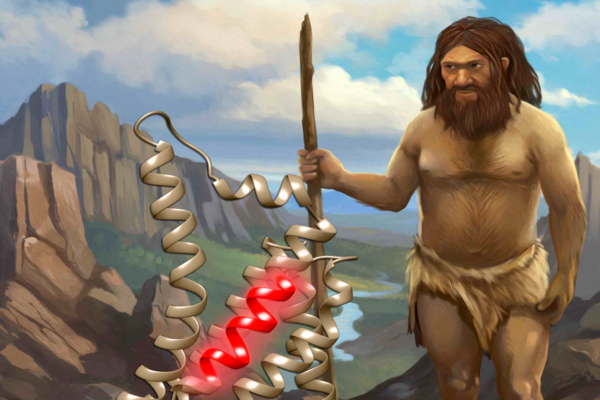De la Fuente is a Presidential Assistant Professor in the Department of Bioengineering and the Department of Chemical and Biomolecular Engineering at the University of Pennsylvania School of Engineering and Applied Science. He has bonus primary appointments in Psychiatry and Microbiology at the Perelman School of Medicine.
 Marrying artificial intelligence with advanced experimental methods, the Machine Biology Group has mined the ancient past for future medical breakthroughs, bringing extinct molecules back to life. Image credit: Ella Marushchenko
Marrying artificial intelligence with advanced experimental methods, the Machine Biology Group has mined the ancient past for future medical breakthroughs, bringing extinct molecules back to life. Image credit: Ella Marushchenko
“We need to think big in antibiotics research. Over one million people die every year from drug-resistant infections, and this is predicted to reach 10 million by 2050. There hasn’t been a truly new class of antibiotics in decades, and there are so few of us tackling this issue that we need to be thinking about more than just new drugs. We need new frameworks,” states Cesar de la Fuente.
De la Fuente’s laboratory, the Machine Biology Group, forms these novel frameworks with the use of likely partnerships in engineering and the health sciences, representing the “power of machines to accelerate discoveries in biology and medicine.”
Merging AI with sophisticated experimental approaches, the team has excavated the ancient past for forthcoming medical advances. In a new study published in Cell Host and Microbe, the group has launched the industry of “molecular de-extinction.”
Human genomes—human genetic material—and the ancient ancestors’ genomes, express proteins with natural antimicrobial properties. “Molecular de-extinction” postulates that such molecules could be key candidates for harmless new drugs. Naturally generated and chosen via evolution, these molecules provide favorable benefits over molecular discovery with the use of AI alone.
In this paper, the team investigated the proteomic expressions of two extinct organisms—Denisovans and Neanderthals, ancient precursors to the human species—and discovered dozens of tiny protein sequences with antibiotic qualities. Their laboratory then worked to process such molecules, getting back to life these long-since-vanished chemistries.
The computer gives us a sequence of amino acids. These are the building blocks of a peptide, a small protein. Then we can make these molecules using a method called ‘solid-phase chemical synthesis.’ We translate the recipe of amino acids into an actual molecule and then build it.”
De la Fuente, Presidential Assistant Professor, School of Engineering and Applied Science, University of Pennsylvania
Next, the research group applied these molecules to pathogens in mice and in a dish to verify the efficacy and veracity of their computational forecasts.
The ones that worked, worked quite well. In two cases, the peptides were comparable—if not better—than the standard of care. The ones that didn’t work helped us learn what needed to be improved in our AI tools. We think this research opens the door to new ways of thinking about antibiotics and drug discovery, and this first step will allow scientists to explore it with increasing creativity and precision.”
De la Fuente, Presidential Assistant Professor, School of Engineering and Applied Science, University of Pennsylvania
This new universe of research is particularly rich. Besides providing a completely recent framework for drug discovery, their study has generated unforeseen insights into the immune system. Notably, some of the peptide sequences in the discussion had no earlier recognized role in immunity.
Indeed, the group’s earlier study had already illustrated that some of the antimicrobial molecules they discovered were hidden away, encrypted inside proteins linked to entirely different systems and functions in the body.
One thing that surprised me is that our lab found sequences in every system of the body—cardiovascular, nervous, digestive, etc. What we didn’t recognize before is that proteins or peptides playing roles in one system could also be contributing to immunity in general.”
De la Fuente, Presidential Assistant Professor, School of Engineering and Applied Science, University of Pennsylvania
The conventional perspective in biology is that one gene encodes for one protein, and every protein has one function. However, what the team and their skilled coworkers discovered is that one protein can have several functions.
“We are opening an entirely new avenue for learning about the ways our bodies prevent and fight diseases,” adds de la Fuente.
Now, the Penn Engineering team is considerately discovering the consequences of reviving the past as de-extinction is demonstrated for these molecules.
“We’re in conversation with bioethicists about what it means to bring genetic material back to life. We’re doing it for medicine, but what if someone else resurrects something toxic or harmful? We’re also collaborating with patent lawyers. Current peptide sequences are not patentable by law. But what about those we recreate from extinct organisms?” says de la Fuente.
Thousands-year-old simple molecule survives and is assisting humans in asking questions that have never been asked earlier.
Source:
Journal reference:
Maasch, J. R. M. A., et al. (2023) Molecular de-extinction of ancient antimicrobial peptides enabled by machine learning. Cell Host & Microbe. doi.org/10.1016/j.chom.2023.07.001